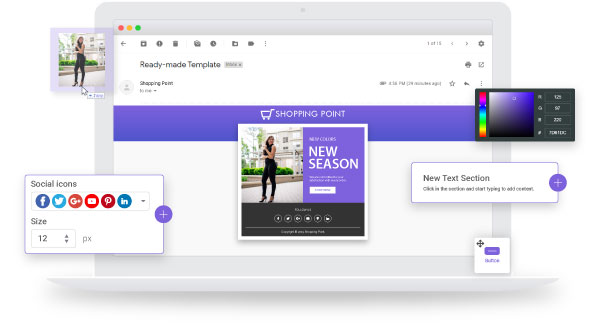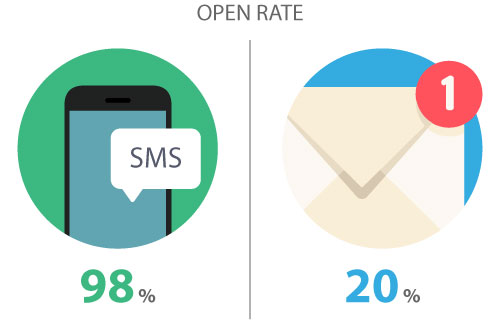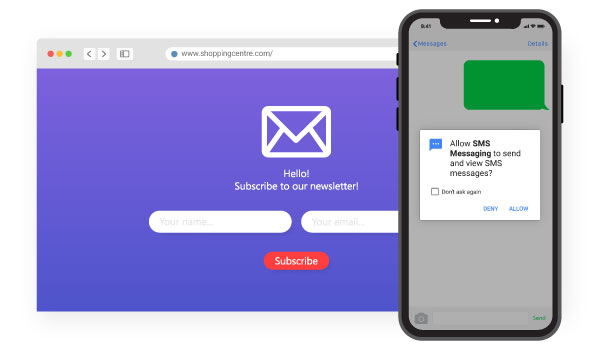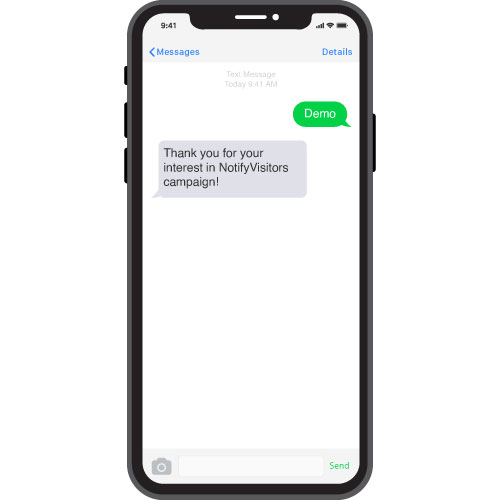In this era of increasingly refined online marketing, Email and SMS marketing are the leading communication channels used by businesses to reach their current and future audiences.
These let them reach customers across all demographics. Each of these has unique advantages in the way they deliver information.
So, it can be bewildering to decide which one to invest in while running a campaign. This blog compares SMS and email marketing and lets you know the right one to invest in. Here we go.
Contents
Email Marketing Vs SMS Marketing: Comparing The Key Variables
Before choosing the method to be employed for any marketing campaign, you need to weigh the key variables. Here is a comparison of the main attributes of email and SMS marketing.
1. Customization

Email offers extensive customization over SMS. You can add images, videos, hyperlinks, and attachments. You can personalize messages with your brand’s colors, GIFs, videos, and images. This can generate higher engagement levels, which in turn can bring sales.
2. Open Rate

In this case, the winner is SMS. It has an average open rate of 98%, while emails have only a 20% open rate. Further, the average person responds to an SMS within 90 seconds, whereas it is 90 minutes for an email.
As soon as your customer hears his or her phone beep, his or her attention is instantly directed to the smartphone.
Thus, amidst the enormous distractions posed by today’s environment to every person, SMS marketing provides a direct route to grab the audience’s attention. For businesses looking to maximize their SMS campaigns, choosing the best SMS marketing app is key to achieving better results.
3. Click-through rate

The click-through rate (CTR) refers to the percentage of your opened emails, and the receiver followed through a link given in it. The CTR for both email and SMS marketing tends to be high.
However, it depends on how well you craft your message and its call to action (CTA). The CTA determines the click-through rate of an email.
A good CTA tells the receiver what you offer and a compelling reason to click through. While it is easier to craft a convincing CTA in emails, it is challenging in texting due to the character limit of 160 characters in SMS. Here, using text abbreviations can be effective in conveying your message concisely and within the character limit.
4. Deliverability
In SMS marketing, your list comprises only engaged customers, but in the case of email marketing, the lists are larger.
However, emails have a greater chance of getting into the spam folder, spoiling your reputation, and damaging your trust with your customers. Stats say that 49% of emails are marked as spam.
It would help if you put in much effort even to get your message into the receiver’s inbox. Additionally, a person working in an office gets more than 120 emails a day, whereas the average millennial gets only 67 SMS per day.
Since a person receives only fewer texts, the chance of him or her reading these messages is higher. Thus, SMS marketing increases the likelihood of your message being delivered to your audience.
5. Cost

No matter which country you are residing in, the cost of texting is certainly higher than that of sending an email. Email marketing is, therefore, more cost-effective for sending non-time-sensitive messages to a big group of receivers.
6. Internet requirement
Unlike emails that require the internet in the form of Wi-Fi or mobile data to be delivered, SMS does not need the internet. So, brands can connect with their audience on the go.
This is especially useful for retail, food, and tourism-related businesses.For instance, a message promoting a meal at your restaurant can impel the receiver to drop in on their way back home from work.
7. Responsive layout
While texting doesn’t have anything to do with creating messages with a responsive layout, emails do. For, not every receiver will open their email using the same device.
They may use laptops, PCs, smartphones, iPad, etc. So, the email created has to be pre-viewed and tested for its appearance across these devices.
Only then will the images, text, graphics, and other content be consistent and flawless across all these devices.
Email Vs SMS Marketing Statistics
- Email currently has 3.9 billion active users (2019 statistics). By 2023, this figure is expected to grow to 4.3 billion, half of the world’s population.
- 293.6 billion emails were sent and received every day in 2019 alone. By 2022, this figure is forecasted to increase to more than 347.3 billion.
- For every $1 spent on email marketing, the average expected ROI is $42.
- 87% of marketers employ email marketing for distributing their content. This makes email rank the third most popular content distribution channel, just after social media and the company’s website.
- 81% of small and medium businesses use email as their primary channel for customer acquisition, and 80% of them for customer retention.
- A vast majority (80%) of business professionals hold that email marketing helps retain customers.
- 83% of B2Bs send e-newsletters as a part of their content marketing program.
- Checking emails is the first thing done by more than half of the consumers (58%) every morning.
- 44% of users check their email to discover deals and discounts from a brand.
- Welcome emails have a high average open rate of 82%.
- While the average email open rate is only 20.81%, personalized emails can have 50% higher open rates.
- 17.75% of clicks through emails resulted in a purchase.
- Segmented email marketing campaigns bring increased email opens (14.31%) and increased CTRs (100.95%) than non-segmented campaigns.
- The industry with the highest click-to-open rate (CTOR) is automotive and transportation (11.9%). In this regard, other high-performing ones are Sports & Recreation (11.2%) and Consumer products & Leisure (11.2%).
- The highest unique open rates are witnessed by industries including energy and environment (30.9%), insurance (31.4%), and automotive and transportation (45.1%).
- Sending three abandoned cart emails brings 69% more orders than sending one single abandoned cart email.
- Including videos in an email can increase its CTR by 300%. So, marketers use GIFs, collapsible menus, and sliders to make their emails attractive to the receivers.
- A large percentage (49%) says that they are happy to receive weekly emails from their chosen brands.
- The rates of unsubscribing and abuse are lower for emails sent by firms having a minimum of 26 employees.
- SMS marketing grew by 197% in B2B and by 92% in B2C marketing efforts from 2015 to 2017.
- The response rate of SMS is 45%, while that of email is only 6%. This means that SMS marketing enjoys a 7.5x higher response rate than emails.
- Response rates to SMS are 295% higher than that of phone call response rates.
- A vast majority (75%) of people don’t mind receiving promotional text messages from a brand after opting for it.
- Over 50% of consumers favor SMS over other communication channels for receiving support from a brand.
- Most (80%) of people resort to texting for business purposes.
- More firms (20%) plan to use SMS marketing than email marketing in the next 12 months.
- 75% of consumers feel comfortable receiving text messages from brands, provided they have subscribed to those.
- 75% of consumers like receiving SMS with special offers.
- 79% of smartphone users rely on subscribed SMS messages to make shopping decisions.
- It was predicted that 48.7 million consumers would subscribe to SMS messages from brands by 2020.
Consumers are much more likely to respond to texts than calls; when verifying personal information, people are almost 300% more likely to respond to texts than calls.
As seen from the above statistics, both SMS and email marketing are currently well-performing and stay here. So, let’s look into the right channel to invest your time, efforts, and money in.
Email Marketing Vs SMS Marketing- Where to invest?
As both SMS and email marketing have their advantages, one should not be discarded in favor of the other. Both should be used in a complementary manner.
When such complementary Email vs SMS marketing is employed, businesses will enjoy the many benefits. Here are five ways to achieve this.
1. Use email to build relationships and texting to secure commitment
Firms should use email marketing when they need to communicate through newsletters and long-form messages. They should keep the message short and crisp.
However, unlike SMS, since there are no character count limitations in emails, the message can include more of the necessary information.
So, use email marketing for most of your messages, and then use SMS marketing to seal the deal.
2. Let your email vs SMS marketing be permission-based

Ensure that you send promotional emails and SMS only to those who have consented to receive those through subscription.
This way, you won’t unintentionally end up annoying receivers by sending them unwanted messages.
This will also ensure that you offer a personalized interaction with the right audience interested in what you have to say.
3. Groom your email subscribers through a text

Often, shorter emails are better than longer ones. However, there are also cases when short emails can belittle your message.
For instance, if you are launching a new product, you need to be elaborate enough to include all info related to specifications and pricing.
You can send an SMS to tell the receiver what they can expect from a forthcoming email message. Because of the brevity of the message, most receivers will just impulsively read it.
4. Use emails to send detailed messages and use texts to receive quick responses
Though people have their mobile phones with them at all times, they may not always respond to emails right away when you are giving discounts or offers; couple up detailed email messages with short summarized texts.
This dual-push often works in urging the recipients to take advantage of the rare opportunity.
5. Derive insights from your email list and personalize text messages
As your email marketing program grows, you will learn what type of content drives engagement and sales. You will also gain valuable insights into your subscriber’s interests and behaviors.
You can use this discernment to target and personalize SMS messages. Though you would still need to refine the process, you would not have to do it from scratch!
Conclusion
Both email and SMS marketing should go into your overall marketing strategy.
You should use email marketing to build relationships and convey detailed information and SMS marketing to send quick reminders and updates that need action.
Such a combined Email and SMS marketing is sure to bring you double-fold benefits.
FAQ’s
1. What are the open rates for email marketing and SMS marketing?
The open rate for SMS marketing exceedingly surpasses that of email marketing. The open rate for the former is 98%, whereas for the latter it is only 20%.
2. How is the CTR for email marketing and SMS marketing?
The click-through rate for email marketing and SMS marketing is quite high. However, it depends on how well you craft your call to action (CTA).
3. How can businesses benefit from a combination of email marketing and SMS marketing?
Businesses should employ email marketing for building relationships and SMS marketing for securing commitment. They should use emails for sending detailed messages and texts for receiving quick responses.
Also Read:

























 Email
Email SMS
SMS Whatsapp
Whatsapp Web Push
Web Push App Push
App Push Popups
Popups Channel A/B Testing
Channel A/B Testing  Control groups Analysis
Control groups Analysis Frequency Capping
Frequency Capping Funnel Analysis
Funnel Analysis Cohort Analysis
Cohort Analysis RFM Analysis
RFM Analysis Signup Forms
Signup Forms Surveys
Surveys NPS
NPS Landing pages personalization
Landing pages personalization  Website A/B Testing
Website A/B Testing  PWA/TWA
PWA/TWA Heatmaps
Heatmaps Session Recording
Session Recording Wix
Wix Shopify
Shopify Magento
Magento Woocommerce
Woocommerce eCommerce D2C
eCommerce D2C  Mutual Funds
Mutual Funds Insurance
Insurance Lending
Lending  Recipes
Recipes  Product Updates
Product Updates App Marketplace
App Marketplace Academy
Academy

